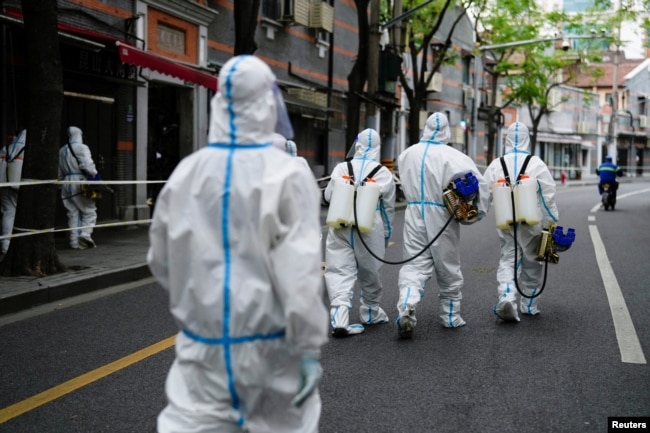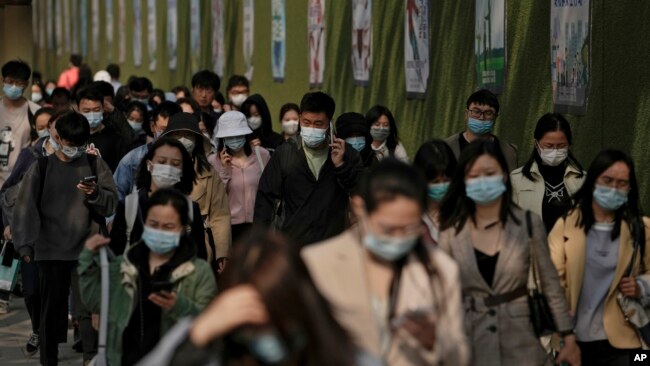
Commuters wearing face masks to help protect from the coronavirus look out from a crowded traveling bus during the morning rush hour, Monday, April 18, 2022, in Beijing. (AP Photo/Andy Wong)
Shanghai has announced its first official deaths since the Omicron version of COVID-19 broke out in the Chinese city last month.
Officials said the three older individuals, who died Sunday, all had preexisting health conditions and had not been vaccinated.
Shanghai Health Commission inspector Wu Ganyu told reporters the patients’ conditions “grew worse” after they entered the hospital and they could not be saved.
International health officials have questioned the low death rate reported from the current outbreak in Shanghai. Most of the city’s 26 million residents have been under stay-at-home orders since early April. The fast-spreading Omicron version of COVID-19 is responsible for most of the new infections.

Shanghai has reported more than 300,000 cases since late March. The government reported 23,460 new cases Monday on the Chinese mainland. Only 2,742 of those cases involved people experiencing symptoms. Shanghai accounted for 95 percent of the total, or 22,251 cases, including 2,420 with symptoms.
The lockdown orders are part of China’s “zero COVID” policy that aims to isolate every case of the virus. News reports note that Shanghai’s policies have led to community disagreements.
Reuters reported that some people’s COVID-19 test results had shown up on local apartment building groups on the WeChat messaging service.
One foreign resident told the news agency he was having trouble entering his test results into the government’s health app. When he could not show proof of his health results, the resident said building administrators attempted to block his family’s food orders unless he shared his test results with other residents.

In some cases, news reports said people who had been placed in quarantine could not get back into their apartments after being released. That would represent a violation of government guidelines.
The Associated Press reported that one Shanghai quarantine center was set up with 50,000 temporary beds, but no hot water. The center is inside the city’s huge National Exhibition and Convention Center.
One woman ordered to the quarantine center with her husband spoke to the AP in a video phone call. The woman, 30-year-old Beibei, asked only to be identified by her given name.
Beibei was ordered into the center with her husband after the two had spent 10 days isolated at home after receiving a positive COVID-19 test. The couple’s 2-year-old daughter, who did not have the virus, went to stay with her grandfather.

The site where BeiBei is staying is among more than 100 set up in Shanghai for people who tested positive, but have no symptoms of the disease. Beibei said she felt some mild symptoms at first, but they went away in a few days.
“At the beginning people were frightened and panicked,” Beibei told the AP. “But with the publication of daily figures, people have started to accept that this particular virus is not that horrible,” she said. Beibei was told she was set to be released Monday after two negative tests while at the convention center.
The Johns Hopkins Coronavirus Resource Center reported Monday it had recorded more than 504 million COVID-19 cases worldwide and 6.2 million deaths. The center said more than 11 billion vaccines had been administered.
I’m Bryan Lynn.
The Associated Press and VOA News reported on this story. Bryan Lynn adapted the reports for VOA Learning English.
We want to hear from you. Write to us in the Comments section, and visit WWW.VOA-STORY.COM
___________________________________________________
Words in This Story
resident – n. someone who lives at a particular place
symptom – n. a change in the body or mind which indicates that a disease is present
isolate – v. to put or keep in a place or situation that is separate from others
quarantine – n. the period of time during which a person or animal that has a disease or that might have a disease is kept away from others to prevent the disease from spreading
positive – adj. in a medical test, positive means the person being tested has a disease or condition
panicked – adj. a sudden, strong feeling of worry or fear
figure – n. a number that expresses an amount
negative – adj. in a medical test, positive means the person being tested does not have a disease or condition